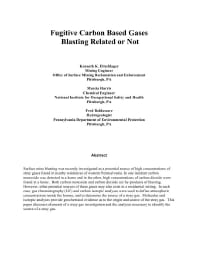Mining Publication: Fugitive Carbon-Based Gases: Blasting Related or Not
Original creation date: February 2004
Authors: KK Eltschlager, ML Harris, F Baldassare
NIOSHTIC2 Number: 20024281
In: Proceedings of the 30th Annual Conference on Explosives and Blasting Technique (New Orleans, LA, Feb. 1-4, 2004). Vol. 1. Cleveland, OH: International Society of Explosives Engineers; :409-418
Surface mine blasting was recently investigated as a potential source of high concentrations of stray gases found in nearby residences in western Pennsylvania. In one incident, carbon monoxide was detected in a home; in the other, high concentrations of carbon dioxide were found in a home. Both carbon monoxide and carbon dioxide are byproducts of blasting. However, other sources of these gases may also exist in a residential setting. In each case, gas chromatography and carbon isotope analyses were used to define atmospheric concentrations inside the homes and to determine the source of a stray gas. Molecular and isotopic analyses provide geochemical evidence as to the origin and source of the stray gas. This paper discusses elements of a stray gas investigation and the analyses necessary to identify the source of a stray gas.

NIOSHTIC2 Number: 20024281
In: Proceedings of the 30th Annual Conference on Explosives and Blasting Technique (New Orleans, LA, Feb. 1-4, 2004). Vol. 1. Cleveland, OH: International Society of Explosives Engineers; :409-418
- An Analysis and Prevention of Flyrock Accidents in Surface Blasting Operations
- Blasting Injuries in Surface Mining with Emphasis on Flyrock and Blast Area Security
- Blasting-Related Carbon Monoxide Incident in Bristow, Virginia
- CO and CO2 Emissions from Spontaneous Heating of Coal Under Different Ventilation Rates
- CO Migration from Trench Blasting in Amherst, New York
- Dangers of Toxic Fumes from Blasting
- Field Studies of CO Migration from Blasting
- Technology News 522 - Blast Area Security: Flyrock Safety
- Toolbox Training on Flyrock Awareness
- Toxic Fume Comparison of a Few Explosives Used in Trench Blasting